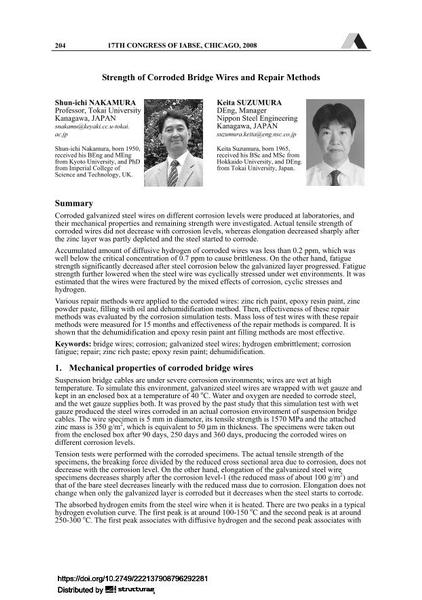Strength of Corroded Bridge Wires and Repair Methods

|
|
|||||||||||
Bibliografische Angaben
| Autor(en): |
Shun-Ichi Nakamura
Keita Suzumura |
||||
|---|---|---|---|---|---|
| Medium: | Tagungsbeitrag | ||||
| Sprache(n): | Englisch | ||||
| Tagung: | 17th IABSE Congress: Creating and Renewing Urban Structures – Tall Buildings, Bridges and Infrastructure, Chicago, USA, 17-19 September 2008 | ||||
| Veröffentlicht in: | IABSE Congress Chicago 2008 | ||||
|
|||||
| Seite(n): | 204-205 | ||||
| Anzahl der Seiten (im PDF): | 8 | ||||
| Jahr: | 2008 | ||||
| DOI: | 10.2749/222137908796292281 | ||||
| Abstrakt: |
Cables of old suspension bridges and stays of cable-stayed bridges often suffer from steel corrosion. Corroded galvanized steel wires on different corrosion levels were produced at laboratories, and their mechanical properties and remaining strength were investigated. Actual tensile strength of corroded wires did not decrease with corrosion levels, whereas elongation decreased sharply after the zinc layer was partly depleted and the steel started to corrode. Accumulated amount of diffusive hydrogen of corroded wires was less than 0.2 ppm, which was well below the critical concentration of 0.7 ppm to cause brittleness. This indicated that hydrogen embrittlement was unlikely to occur. On the other hand, fatigue strength significantly decreased after steel corrosion below the galvanized layer progressed. Fatigue strength further lowered when the steel wire was cyclically stressed under wet environments when compared with the fatigue strength under dry environments. It was estimated that the wires were fractured by the mixed effects of corrosion, cyclic stresses and hydrogen. Various repair methods were applied to the corroded wires: zinc rich paint, epoxy resin paint, zinc powder paste, filling with oil and dehumidification method. Then, effectiveness of these repair methods was evaluated by the corrosion simulation tests. Mass loss of test wires with these repair methods were measured for 15 months and effectiveness of the repair methods is compared. It is shown that the dehumidification and epoxy resin paint ant filling methods are most effective. |
||||
| Stichwörter: |
Korrosion Reparatur Wasserstoffversprödung
|
||||
